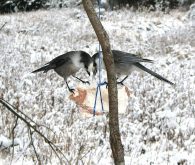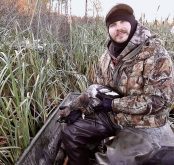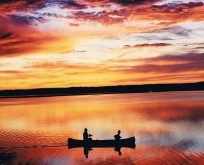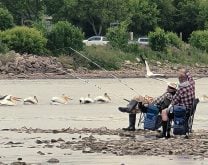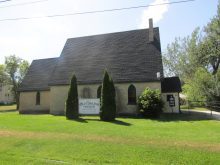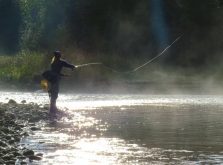Ordinarily the skating rinks of rural Manitoba would be bustling community hubs.
There would be the scrape of skates along the ice, the crack of a hard shot and the thud of the pucks along the boards.
But today they’re ghost towns, as COVID-19 restrictions have closed and locked their doors. The parking lots are empty, the hamburger grills are cold and the stands and locker rooms are empty.
But even so, some are still strapping on the skates — just a bit closer to home.
Read Also
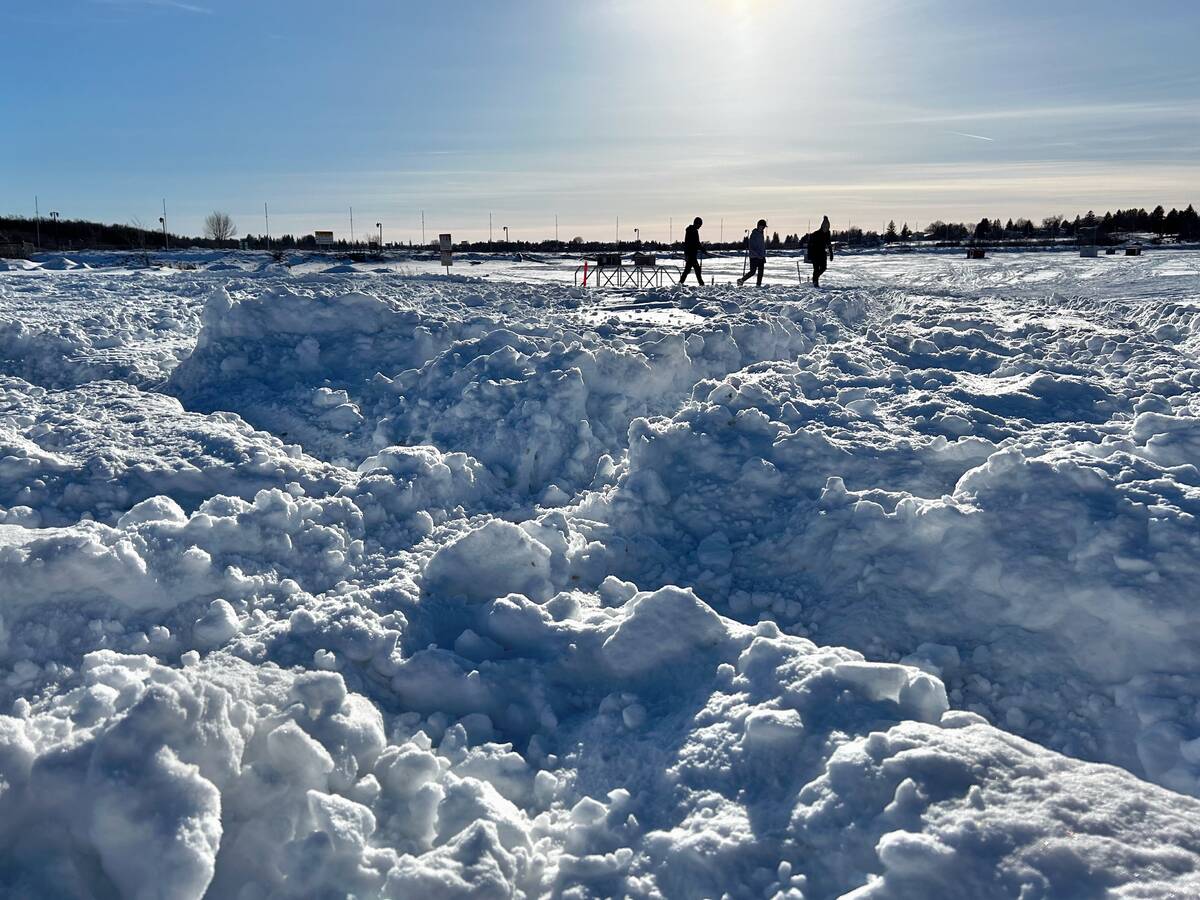
Predicting Manitoba winter snowfall
How much snow should farmers in Manitoba expect for the rest of December 2025 and into January-February 2026? Here’s what the weather models say about the winter to come.
Michael Grenier of Winkler would normally visit his local rink up to five times a week this time of year, coaching hockey. But this year, any skating is happening in his own backyard. He’s one of countless rural Manitobans who are flooding rinks in their own backyards this winter, in an effort to combat the COVID blues.
It is not Grenier’s first time converting his backyard into a skating rink, although he skipped last year after a surprise snowstorm in October. This year, however, COVID-19 restrictions cancelled the youth sports that would ordinarily keep the Grenier children active and forced the family to stay home.
“That just kind of kicked me in the pants that I had to make sure that I had the rink going this year,” he said.
This year’s rink is much the same to previous years, although Grenier invested in silage tarp as a liner this year, as well as full plywood sheets at one end to defect pucks. But it’s still two feet of plywood making up the sideboards of the rink. Water still comes cold from the garden hose.
“Mine is pretty straightforward and basic, but there’s definitely some elaborate ones,” he said, pointing to some backyard rinks hooked up with construction lighting, full boards, hot water setups and homemade Zambonis for an arena-quality ice finish.
Dean Schenk of Weyburn, Sask., has one of those more elaborate setups.
In a shift that would later earn him news headlines, Schenk moved his traditional backyard rink into an unheated shed this year. He then proceeded to make a true rink in miniature, installing sideboards with mock sponsorship logos and using hot water, a homemade Zamboni and his own years of experience with home rinks to maintain the quality of the ice.

Unlike Manitoba, minor hockey in Schenk’s region did not shut down in November. Still, the increased uncertainty caused by COVID-19, and the possibility of future shutdowns to match Manitoba, inspired Schenk to take his home rink up to the next level.
“I wanted to switch it up and do something a little more special for the kids, regardless of whether we can have team sports or not,” he said.
The end result may look more elaborate, but Schenk said the indoor construction was actually, “quite a bit easier, being able to use the shop walls to support the liner.”
“Typically I would frame in boards in the backyard to support the water, and then you’re dealing with the slope of the yard and things like that,” he said. “It’s cement floor in the shop, so it used a lot less water.”
Likewise, he said, the more elaborate setup did not equate to extra cost, since most of the materials were already on hand, although Schenk did purchase a new tarp this year.

Beating the heat
The indoor move served the Saskatchewan resident well as temperatures in Western Canada jumped into melting range through early December.
“We’ve had less than ideal weather for making ice, but being indoors not in direct sun, we use it almost daily,” he said. “The kids usually go out right after supper and they’ll go out there for a couple of hours every evening.”
Grenier’s addition of silage tarp, likewise, has helped his rink weather the warmth.
The tarp made it easier to retain water, compared to the eight-foot poly strips he previously taped together for a liner, Grenier noted.
“The silage tarp definitely was a game changer for us this year,” he said.
The last days of the hot snap still rendered the rink unusable, according to Grenier, although he had previously got the ice thick enough that his children were still able to skate during the first weekend of December, despite temperatures well above freezing.
Troy Basaraba of Rivers, Man., likewise, noted that the addition of a white silage tarp helped maintain his home rink ice far better than his previous coloured liner.
Sports down for the count
It is also not the first time that a backyard rink has appeared around the Basaraba house. The western Manitoba family has installed a home rink every winter for the last three years.
But what began as a way to hone hockey skills is now a much-needed outlet as the usual roster of extracurricular activities and recreational hockey leagues fall by the wayside.

“Two of my boys, they were in minor hockey when we first got going, so it was one of those (things) where you just threw it in the backyard to sharpen up the skills and go for that skate and keep the boys sharp and stuff like that, and they had such a whopper of a time on it that we just continued it last year,” Basaraba said.
“Then, this year, with the COVID hitting and all that other sort of stuff, it was like, ‘yeah, this will be a must thing to do this year to get the kids outside and get them some fresh air and get them active.’”
The Basarabas’ acreage has proven a blessing in that regard, he added. Their children, aged eight and 10, are facing a much different year than last year, when their schedule was filled with activities ranging from 4-H beef to curling and guitar lessons.
“It’s very easy to kick the boys outside to go run around the backyard and burn off energy,” he said. “We brought in some 4-H animals and moved the cows out back, so they’ve been helping with building corrals and taking care of the chickens and all that other sort of stuff. As COVID hit and we’ve adjusted, there’s been lots of other stuff here that we’ve been able to lessen the blip in the radar for these kids.”
Business boon
Home rink demand has brought business in to the Manitou Building Centre, salesman Josh Friesen said. More local consumers have been looking for tarps, framing lumber and full kits for various rink sizes, he noted, ranging up to 40×80-foot rinks.
It’s a significant change from last year, when demand for home rink supplies was pretty much dead.
“I would say that last year we wouldn’t have any demand for people putting in backyard rinks, especially when you have a local rink here that’s open,” he said.
“This has kind of been the first year that we’ve had people calling and wanting to set something up themselves,” he added.
Costs and maintenance
The costs for these backyard winter oases vary.
Grenier estimates it would cost between $500 and $600 for someone starting from scratch to install something similar to his 30×40-foot rink. Of that, the silage tarp cost him $300 this year.
Basaraba, likewise, spent $350 on silage tarp this year, although he noted that the 40×100-foot tarp is enough for two of his 24×48-foot rinks and so will last him for several years.
Friesen, meanwhile, says a large 40×80-foot rink would cost about $800 in tarp, lumber and stakes.
Most who have come looking for building supplies already have a fair idea of the how-tos of their venture, Friesen said, although staff have had to guide some customers through the process.
“I think everybody’s been watching videos online, it seems like,” he said.
The biggest issues, he added, have mostly revolved around finding level space.
After the initial time commitment to set up the rink, Grenier estimated that maintenance takes about 20 minutes a day, as well as any scraping to clear the ice after a snowfall.
“I find it therapeutic,” he said. “Once (the kids) go to bed in the evening I kind of take that half-hour and hook it up and give it a flood and have some music going.”
Going natural
Others, meanwhile, have turned to their area’s natural rinks, either in addition to or in place of putting ice in the backyard.
Schenk is also one of those, despite creating an indoor rink of his own.
“I grew up skating on a dugout or a river, so I like to still give the kids that experience,” he said.
Despite his home-built facility, the Schenk family schedule has also included joint skating/ice fishing trips, and he says his is not the only one in his area looking for natural rinks.
“There’s been people on the river skating almost daily,” he said. “I’ve seen, definitely, a lot more dugouts being cleared off.”




